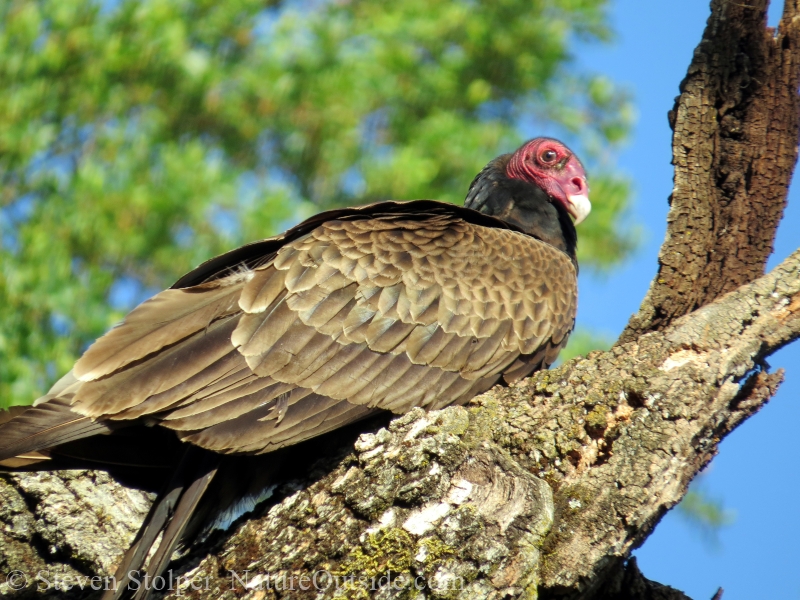
Awake before dawn, I’m on the trail at first light.
Mountain lion, coyote, and skunk have given way to the day shift. I follow a winding dirt path as it enters a stand of mixed oak forest. My mind wanders as I hike. Part of my brain is still home in bed under the warm covers.
The sweet smell of California Bay Laurel snaps me out of my reverie. The scent is reputed to stimulate energy, and it has always had that effect on me.
Despite the sun, the morning is chilly. And as I gaze with my newly inspired awareness, I notice a large shape warming itself on the ruins of an old fence. From the cover of the trees I snap a few pictures.
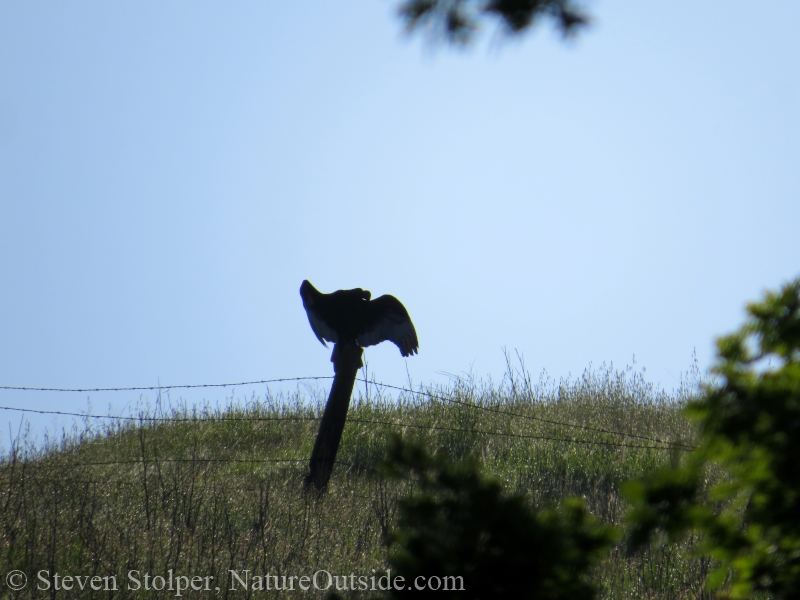
Turkey Vulture warming itself in the sun
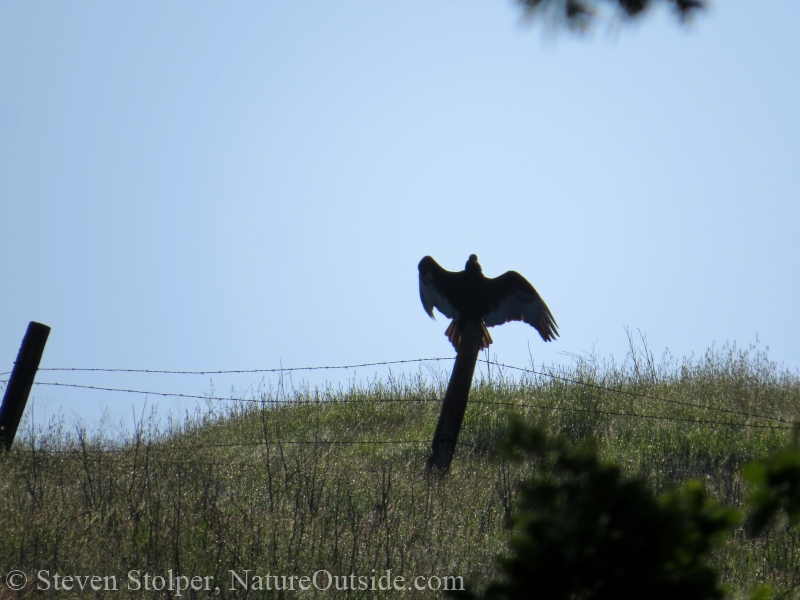
This posture is called the horaltic pose.
It’s a Turkey Vulture (Cathartes aura). And I’ve never seen one sunbathe like this. It reminds me of a Cormorant waiting for its wings to dry before it can fly again.
Turkey Vultures are often seen standing in this “horaltic pose.” It’s not clear why they do it. Explanations include warming the body, drying the nighttime dew from their feathers, realigning their flight feathers, or baking off harmful bacteria.
I hike on and surprise another bird sunning itself on a snag. The trail I’m hiking is new, and it seems surprised to see a human in the area. Could this be a nest?
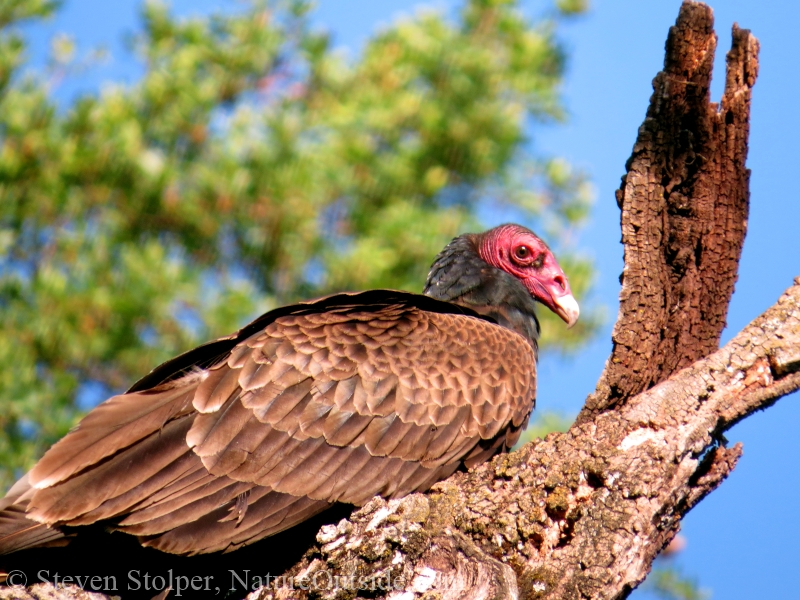
Turkey Vulture seated on a snag.
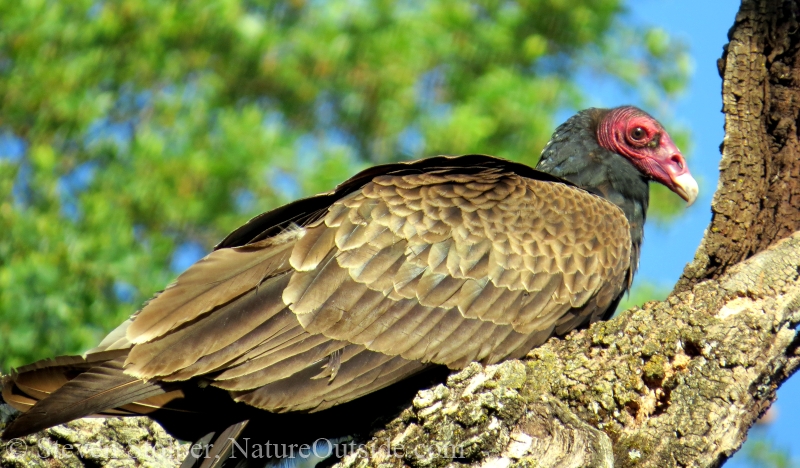
Notice the bald red head
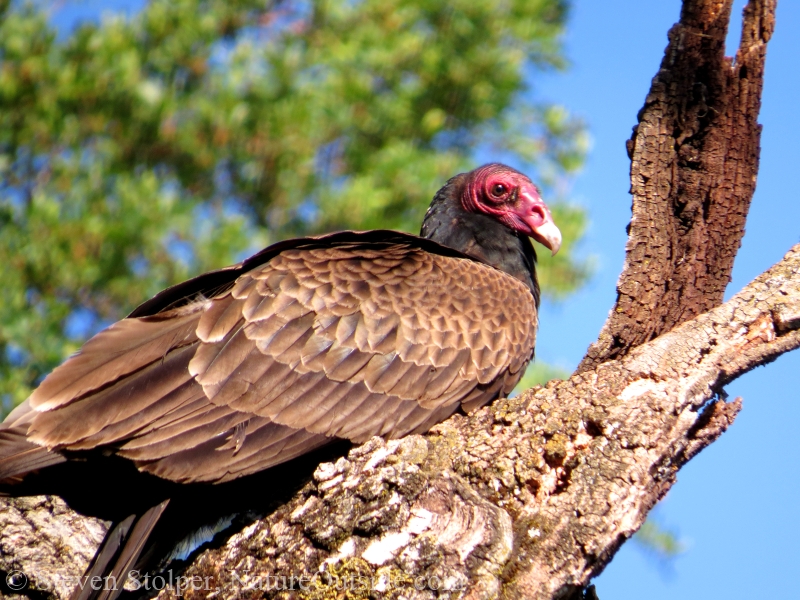
Turkey Vultures are large birds, weighing up to four pounds.
Turkey Vultures are large birds. They can be as long as 32 inches and have a wingspan of almost six feet across. And they can weigh as much as four pounds.
Most of the time we see them soaring high overhead. But when viewed up close, their bald red head is startling. Their scientific name “Cathartes”, meaning “cleanser” or “purifier.” And that’s what they do. By consuming carcasses, they save us from wading through piles of dead animal corpses every time we go for a stroll. The featherless head and neck permit the Turkey Vulture to reach deep inside a decaying carcass to feed without fouling its feathers.
I continue my hike and make a discovery several hours later. At the edge of my vision, I see what appears to be a deer carcass lying on a grassy slope. Using my binoculars I examine the body. It appears to be fresh.
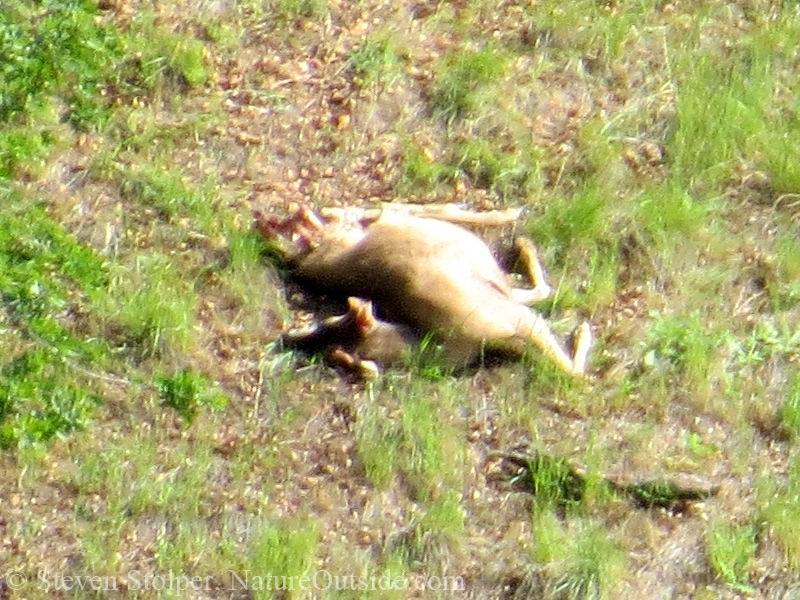
I spot a deer carcass across the valley.
As I watch, a cluster of familiar forms appear.
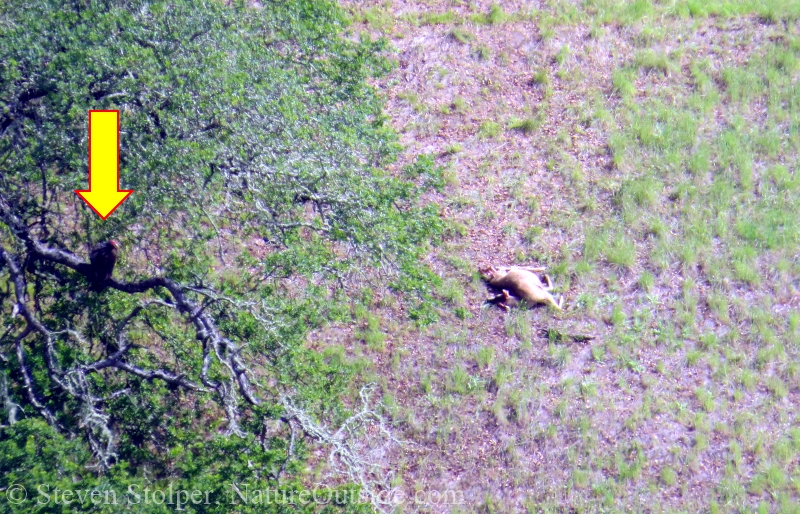
A Turkey Vulture (yellow arrow) inspects the carcass.
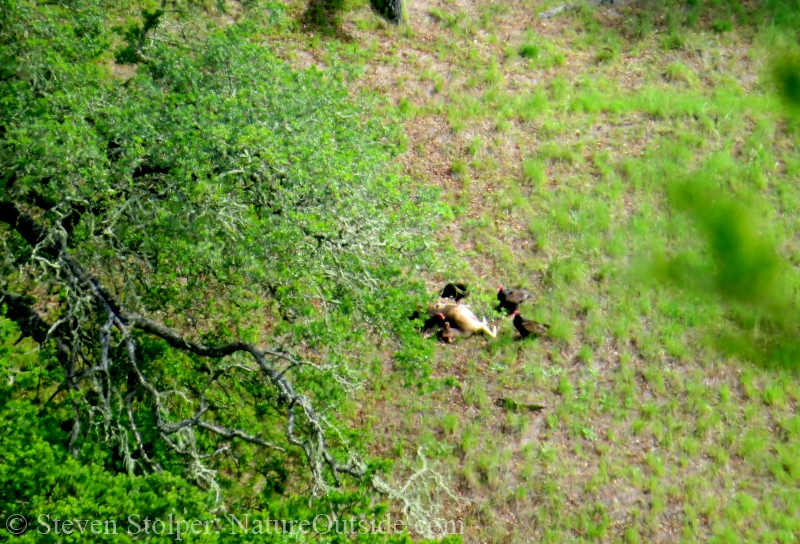
A group of Turkey Vultures quickly alight beside the carcass.
Although many Turkey Vultures may appear at a carcass, typically one feeds at a time. It chases the others away until it’s done. The other birds remain close by as they await their turn.
But this corpse presents a problem. I am too far away to see how it died. But there doesn’t appear to be a wound. So the birds have no way in to the carcass. They just hover around like angry patrons at the world’s slowest Burger King.
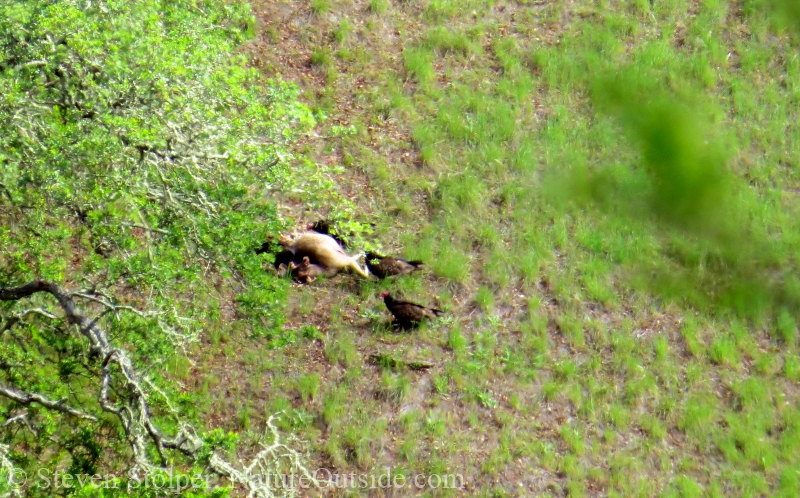
The birds are baffled. There is no access to the inside of the carcass.
Then, with some unspoken command, the birds disperse. There is no meal here. But several remain, waiting for another scavenger to open the carcass for them.
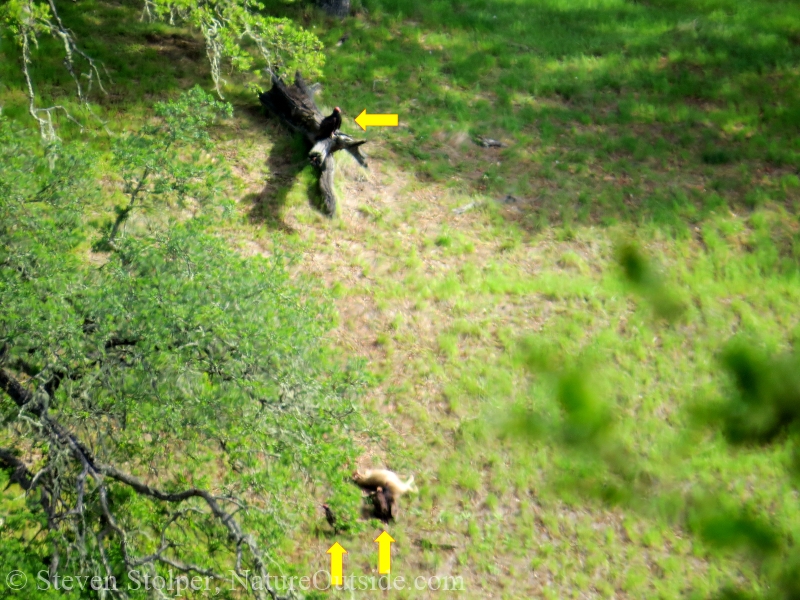
The vultures disperse, waiting nearby for another scavenger to open the carcass for them.
Turkey Vulture Facts
Turkey Vultures are so common in the United States that we don’t often spare them a thought. But they’re amazing animals.
Turkey Vultures are more closely related to storks than to hawks. They locate their food using their excellent sense of smell. This is unusual in birds. Most other vultures use their keen sight to spot prey from above.
The vultures feed on mammals, reptiles, other birds, amphibians, and fish. They prefer freshly dead meat. But are unable to open the carcasses themselves unless the body is soft.
Their food supply is unpredictable. So Turkey Vultures can ingest large quantities of meat rapidly, and then go for many days without feeding.
Turkey Vultures don’t build nests. They scrape out a spot in hollow trees, caves, and sometimes on the ground. They lay between one and three eggs.
During hot weather, Turkey Vultures are known to squirt liquid excrement onto their legs and feet. This is called urohydrosis (I call it disgusting!). It’s thought that it has a cooling effect that helps the birds thermoregulate.
When threatened, turkey vultures hiss. And if that doesn’t work, they can projectile-vomit at the animal bothering them. A warning to you: They can be accurate out to 10 feet.
Turkey Vultures live up to 20 years. And they are well habituated to human activity.
Turkey Vulture Identification
You’ve probably seen their hunched forms sitting on trees, telephone poles, or antenna towers.
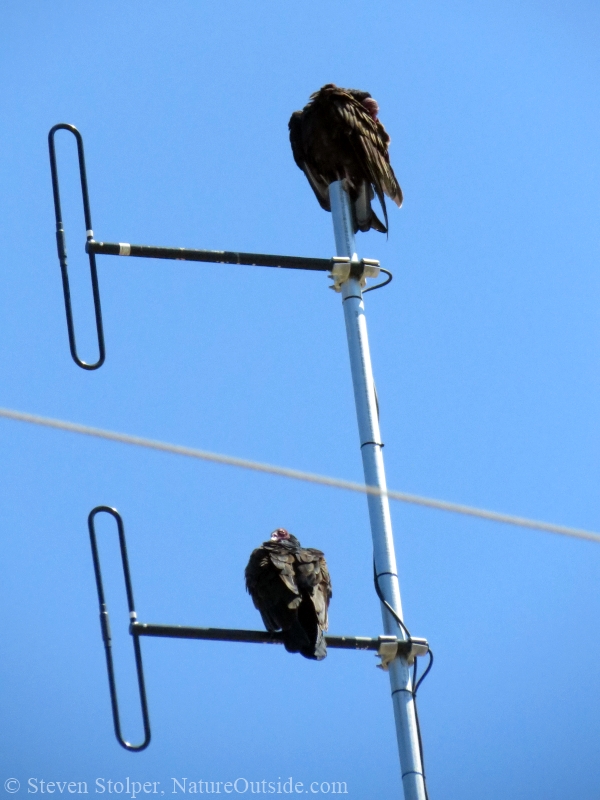
Turkey Vultures perched on a communications tower.
But they are easiest to spot in flight. They soar with long, broad wings. They rarely flap, and are much bigger than red-tailed hawks. Only eagles and condors are larger.
They have long “fingers” at their wingtips and long tails that extend past their toe tips in flight. Their wings have a two-tone silver/black look when seen from underneath. When soaring, Turkey Vultures hold their wings raised in a pronounced ‘V’ when seen head-on. This pronounced dihedral makes them easy to distinguish from hawks.
Turkey Vultures have an unsteady flight, almost teetering as they search for thermals. They may soar in groups and with other species in “kettles.” A kettle is a term that birders use to describe a group of birds wheeling and circling in the air. The vultures spiral up like water boiling in a pot.
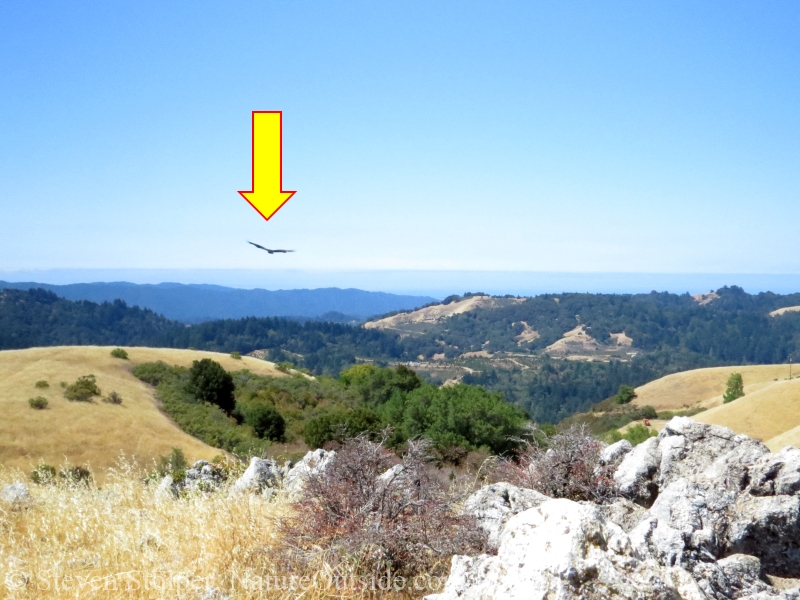
Turkey Vulture soaring. The wings are usually more “V” shaped than this one.
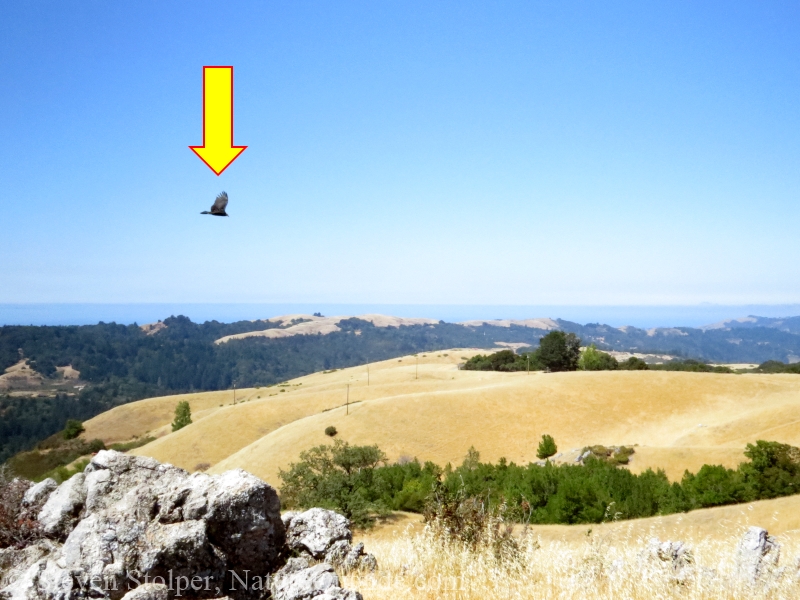
Seen from the side, you can see the wings are held in a “V” (dihedral).
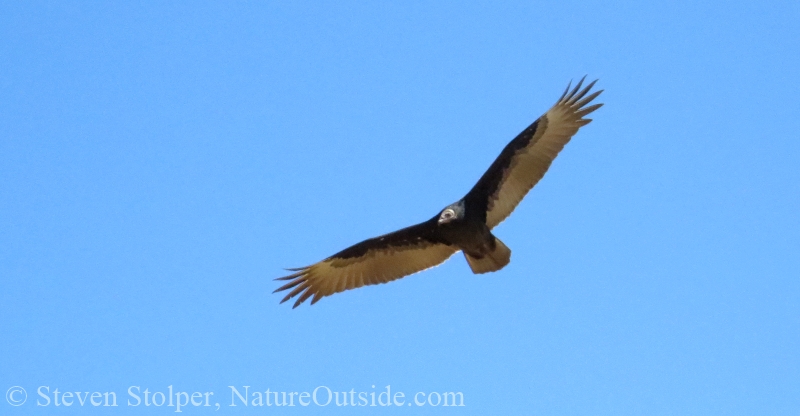
Seen from below, their wings appear two-tone (black and silver).
What have you noticed about your local Turkey Vultures? Leave a comment below.
References
The Sibley link is an affiliate link.
California Nature Mapping Program
The Cornell Lab – All About Birds
Sibley Guide to Bird Life & Behavior
Related Articles on NatureOutside
Where do Birds go When it Rains?
Urban Creatures – The Amazing Garter Snake
Urban Creatures – Bald Eagles!
For fun facts and useful tips, join the free Bushcraft Newsletter.



Hi, Steve. Really enjoyed this article on the Turkey Vultures. Who knew??? Vomit accurate to 10 feet! I’ve never been that close to one but now know not to tempt fate. My husband & I have been out enjoying our (mostly) Santa Clara County trail hikes and all of the wildflowers this year. From now on, I’ll keep my eyes open with a new appreciation for our vultures.
Thanks for your comment, Ardis!
Fortunately, I have never been in range, either. 🙂 But I have been close enough to appreciate the size and unique appearance of these birds. Have fun on your hikes. We have an abundance of Turkey Vultures in Santa Clara County.
Hi Steve, I found your article while searching Turkey Vulture habits. I live in a rural area of Napa Valley and a few months ago I was outside before dawn when the sky was just starting to lighten up.. I walked out back and just happened to look up. I was surprised to see what I thought were turkey vultures flying low overhead. They were flying from east to west, in rows of two or three abreast and row after row. I counted thirty of them. I have no idea how many went by before I started counting. They were large birds, dark, all were flapping their wings non stop. It looked like they were headed somewhere with purpose. They were flying at tree top level and they were quiet. I never heard a sound. I was fortunate to have looked up. I have not seen a repeat since then. I have been unable to find any similar behavior in my research. Any thoughts on what I saw?
Thanks
Phil
Phil, that sounds like an amazing sight! There are two explanations that come to mind.
The first is that they were traveling from their roost to the coast, where they could use the wind from the ocean to gain height. Outside of the breeding season, Turkey Vultures can form roosts of dozens to hundreds of birds. You may have seen such a group.
The second is that they may have been migrating. Turkey Vultures live in our area year round. But more than a million Turkey Vultures living in western North America migrate to Central America, and in some cases as far south as Venezuela, Colombia, and Ecuador (Cornell University).
It’s great that you were awake early to see them. In this case, the early bird catches the Turkey Vultures! 🙂